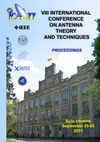Marine viewfinder
DOI:
https://doi.org/10.1109/ICATT.2011.6170773Keywords:
finder, binoculars, navigation conditions, emergency situationAbstract
The possibility of creation of a marine viewfinder in the form of the field-glass at which one eyepiece remains optical is considered, and the second — represents the radar-tracking channel of a millimeter wave band with a conclusion of the data about distance to object of supervision.References
YUDOVICH, A.B. Prevention of Navigation Accidents of Marine Ships. Moscow: Transport, 1988, 224 p.
NECHIPORENKO, A.N.; FESENKO, L.D.; KRIVOSHEEVA, G.M. On the solution of constructing a ship's radar high-class accuracy for the goals of the short-range navigation. Radioelectronics, 2008, v.51, n.7, p.22-29.
http://www.usts.kiev.ua/product/barsuk.html.
ERMAK, G.P.; VARVIN, A.V.; POPOV, I.V.; VASILIEV, A.S.; WHISKERS, U.S. Radar sensor monitoring employment path and speed of rolling hills in the territories of sorting. Science and Innovation, 2009, v.5, p.9-16.
VARVIN, A.V.; VASILIEV, A.S.; ERMAK, G.P.; POPOV, I.V. Autodyne transmit-receive modules on a Gunn diode with an internal detection of signal for the radar sensor with a linear modulation. Proceedings of the IRE AS Ukraine, 2008, v.3.
GORBACHEV, A.V.; KARUSHKIN, N.F.; KOSATKIN, L.V. Solid-state transceiver of pulsing activity for RLS a millimeter band of waves. Electronic Engineering, 1998, n.2, p.57-62.

